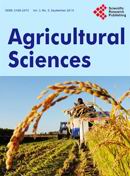View Item
- xmlui.general.dspace_homeCentros Regionales y EEAsCentro Regional Santa FeEEA RafaelaArtículos científicosxmlui.ArtifactBrowser.ItemViewer.trail
- DSpace Home
- Centros Regionales y EEAs
- Centro Regional Santa Fe
- EEA Rafaela
- Artículos científicos
- View Item
Effects of supplementation with increasing levels of energy concentrate on the productive response and ruminal digestion of dairy cows grazing lucerne pasture
Abstract
The aim of the study was to determine the effect of three levels of energy concentrate intake on dry matter (DM) and energy intake, milk yield and composition, rumen environment and pasture neutral detergent fiber (NDF) digestion. Twelve Holstein multiparous cows in early lactation (69.0 ± 5 days postpartum) producing 32.8 (±4.0) kg milk were assigned to three treatments at (kg/cow day) 3.5 (T3.5), 7.0 (T7.0) and 10.5 (T10.5) kg concentrate in a 3 × 3
[ver mas...]
The aim of the study was to determine the effect of three levels of energy concentrate intake on dry matter (DM) and energy intake, milk yield and composition, rumen environment and pasture neutral detergent fiber (NDF) digestion. Twelve Holstein multiparous cows in early lactation (69.0 ± 5 days postpartum) producing 32.8 (±4.0) kg milk were assigned to three treatments at (kg/cow day) 3.5 (T3.5), 7.0 (T7.0) and 10.5 (T10.5) kg concentrate in a 3 × 3 Latin Square design. Parameters of ruminal environment and neutral detergent fiber (NDF) digestion were obtained using 3 additional rumen cannulated cows. Concentrate was composed (as fed) by corn grain (68%), soybean meal (22%), wheat bran (8%) and a vitamin-mineral premix including monensin and thoroughly consumed. Yields (kg/cow day-1) of milk, 4% fat corrected milk (4% FCM 4%) and energy corrected milk (ECM) resulted higher (p < 0.05) in T7.0 (29.6, 26.1 and 25.7) compared to T3.5 (27.7, 24.5 and 24.2) but similar to those obtained in T10.5 (30.6, 26.2 and 26.0). Milk protein yield increased linearly (p < 0.01) from 0.82 to 0.92 kg/cow day-1 without effects on yield of milk fat. Concentrations (g/100 g) of milk fat (3.19), protein (2.97), total solids (11.75), non-fat solids (8.60) and casein (2.40) did not differ. Milk lactose content (g/100 g) was linearly increased (p < 0.02) from 4.91 to 4.98 whereas milk urea decreased (p < 0.01) from 0.048 to 0.043. Intakes of DM and energy increased with concentrate level without effects on conversion efficiency. Changes in live weight (LW), body condition score (BCS) and concentrations of plasma non-esterified fatty acids (NEFA), glucose, insulin, somatotrophin (GH) and insulin-like growth factor (IGF-I) were not affected. Plasma urea levels resulted lower (p < 0.05) in T10.5. Ruminal pH and ammonia nitrogen (N-NH3) resulted lower (p < 0.05) in T10.5 compared to T3.5. Concentration of total volatile fatty acids (VFA) was higher (p < 0.05) in T3.5 due to the increase in acetate and butyrate while the acetate: Propionate ratio remained unchanged. Pasture NDF digestion was affected as concentrate intake increased. To increase milk protein yield and reduce concentrations of N-NH3 in rumen and milk, feeding an energy concentrate at 41% of total DM intake resulted an effective tool.
[Cerrar]

Fuente
Agricultural Sciences 9 (11) : 1487-1505 (November 2018)
Date
2018-11
Editorial
Scientific Research
ISSN
2156-8561
2156-8553
2156-8553
Formato
pdf
Tipo de documento
artículo
Palabras Claves
Derechos de acceso
Abierto
 Excepto donde se diga explicitamente, este item se publica bajo la siguiente descripción: Creative Commons Attribution-NonCommercial-ShareAlike 2.5 Unported (CC BY-NC-SA 2.5)
Excepto donde se diga explicitamente, este item se publica bajo la siguiente descripción: Creative Commons Attribution-NonCommercial-ShareAlike 2.5 Unported (CC BY-NC-SA 2.5)


